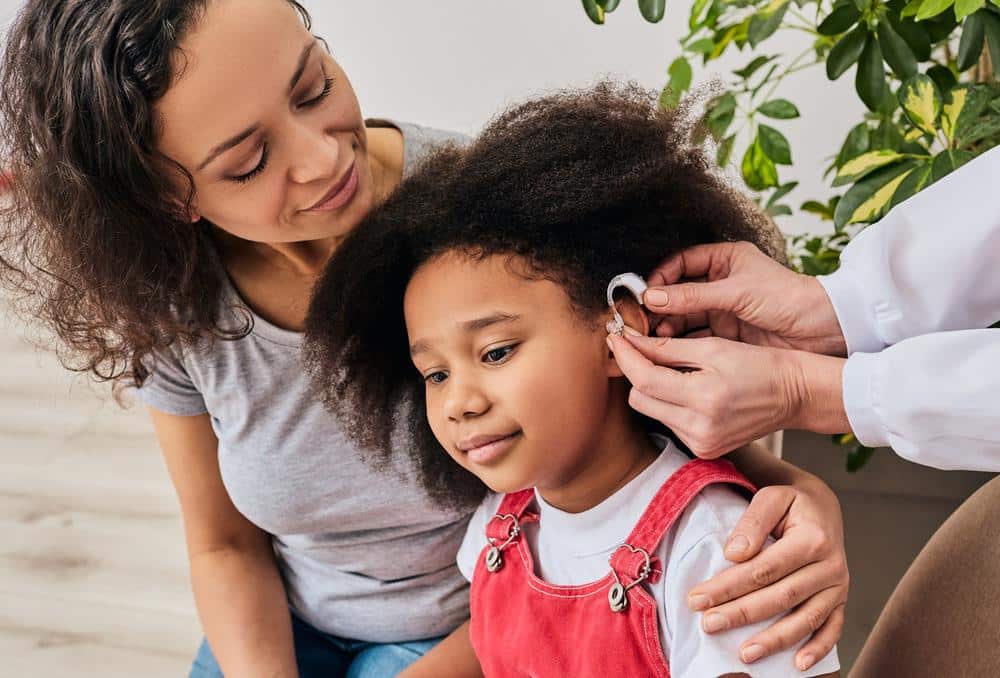
Pediatric Hearing Loss
Evaluation and Diagnosis for Hearing Disorders
Our team at Virginia Ear, Nose & Throat proudly offers evaluation and customized management plans for pediatric hearing loss in infants and children. According to the CDC, for every 1,000 children in the United States, 1 to 3 of them will have hearing loss. Pediatric hearing loss can come in many forms—congenital (at birth), acquired, temporary or permanent.
Newborn Hearing Screenings
The Commonwealth of Virginia mandates that infants receive a hearing screening at the time of birth, usually before leaving the hospital. There are two tests used for newborn screening: Otoacoustic Emissions (OAEs) and Auditory Brainstem Response (ABR). Both are safe and reliable. During an OAE, a small probe is placed into the ear. A sound will then be played, and a microphone will measure an echo that is reflected back in an infant’s ear canal. OAEs will be present or absent. For the ABR, sounds are presented into the ear and recorded using electrodes. This test measures how the hearing nerve responds to sounds and can identify degrees of hearing loss.
If the infant does not pass this screening, they will be referred to a state-accredited practice to perform additional testing, follow-up and ongoing care. Virginia Ear, Nose & Throat is an approved practice to conduct this testing and care. Our team of compassionate, expert physicians and audiologists are committed to the goals laid out by the state, including:
Symptoms of Pediatric Hearing Loss
If your child’s pediatric hearing loss develops after a newborn hearing screening, they may exhibit some of the following signs and symptoms. In infants, this may look like:
In children, pediatric hearing loss signs and symptoms include:
Left undiagnosed, hearing disorders and pediatric hearing loss in infants and children can negatively affect their speech and language development, learning and comprehension skills and overall behavior.
Types of Pediatric Hearing Loss
We understand that navigating any kind of hearing disorder with your child can be stressful and emotionally taxing. Our team is here to evaluate and diagnose your child’s hearing disorder, help you fully understand the implications of their condition and what management and treatment options are available to them.
Hearing disorders in children can either be congenital or present at birth, usually due to a genetic condition or infection during pregnancy, or acquired (developed over time). Loss of hearing can range from temporary to permanent. Types of pediatric hearing loss include:
Prevention of Pediatric Hearing Loss
Not all hearing disorders in children can be prevented—however, they are some steps you can take to reduce your child’s risk. Pediatric hearing loss prevention tips include:
Pediatric Hearing Loss Evaluation, Diagnosis and Treatment
If you suspect your child is experiencing temporary or permanent pediatric hearing loss, contact our team at Virginia Ear, Nose & Throat Associates. Our audiologists will conduct a thorough evaluation to identify potentially treatable causes and attempt to restore lost hearing function. Facets of a hearing evaluation include reviewing medical history, audiograms (pure tone hearing test), otoacoustic emissions test (measures the function of the hair cells in the inner ear), tympanometry (measures the function of the middle ear), auditory brainstem responses (measures the connection between the inner ear and the brain), and radiographic imaging. If a CT scan is necessary, we often will use the MiniCAT scanner. The MiniCAT scanner emits much lower doses of radiation while producing quality images, making it very child-friendly.
Treatment varies based on the degree of hearing loss and its root cause. However, some common treatment options include medication, surgery, hearing aids and in some cases, cochlear implants. If our team finds evidence of a hearing disorder in your child, they will work with you to develop a customized treatment and management plan, and help to educate you so that you fully understand your child’s pediatric hearing loss condition.

